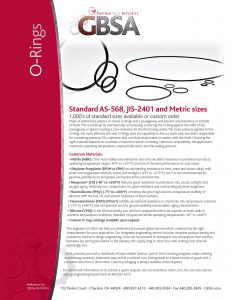Custom O-Rings Bring Sealing Full Circle
Generally made of elastomers, plastics or metal, O-Rings seal a passageway to prevent unwanted loss or transfer of fluids. This is achieved by mechanically compressing or placing pressure on the O-Ring against the walls of the passageway or gland, creating a zero-clearance, positive block to the fluid being sealed. The more pressure applied to the O-Ring, the more effective the seal.
Our engineers can help you determine which O-Ring has the right physical limits for your unique application. To further improve your operating productivity, we can also assist in determining proper gland design, material selection and back-up rings that will serve your needs.
O-Ring Size Charts
Click on the link below to download charts (PDF) showing o-ring sizes.
- O-Ring AS 568 Dash Size Charts
Shows o-ring AS 58 dash sizes from -001 to -471. - O-Ring JIS2401 Size Charts
Shows JIS2401 o-ring “P” and “G” sizes. - Metric O-Ring Size Charts
Shows metric o-ring sizes from M1X1.15 to M8.4X399.5.
O-Ring Elastomer Types
A very important component of a seal is the elastomer type. GBSA can specially compound elastomers for specific sealing requirements. Below we provide general properties and fluid compatibilities.
| ELASTOMER TYPE |
HARDNESS
SHORE A |
GENERAL PROPERTIES |
| NITRILE (NBR) Acrylonitrile Butadiene |
35 to 95
|
Low, medium and high nitriles are available based on increasing acrylonitrile content which significantly affects low temperature and fluid swell properties. Nitrile compounds can exhibit very good tear and abrasion resistance and excellent compression set. Unless specifically compounded, they do not have a good resistance to ozone, sunlight or weather. |
| THERBAN (HNBR) Hydrogenated Acrylonitrile Butadiene |
55 to 75
|
This material is a hydrogenated acrylonitrile butadiene and unlike standard nitriles it exhibits resistance to the ozone and other atmospheric conditions. Therban also exhibits a very good resistance to heat and aging in the 300°F range and refrigeration. All other properties are NBR. |
| FLUOROCARBON (FPM) Fluorinated Hydrocarbon |
55 to 93
|
This polymer exhibits very good resistance to petroleum products, low compression set and high temperature resistance. |
| NEOPRENE (CR) Chloroprene |
40 to 70
|
Compounds from neoprene exhibit good ozone and weather resistance. Due to the excellent resistance to refrigerants such as Freon, these compounds are used in refrigeration systems. |
| ETHYLENE PROPYLENE (EPDM) (EPM) |
35 TO 85
30 TO 80 |
Compounds of this material exhibit excellent resistance to automotive brake fluids and steam as well as ozone, sunlight and weather. |
| SILICONE (VMQ) | Silicone compounds are noted for their excellent heat resistance and exhibit the best over all temperature range of all available elastomers. Not recommended for dynamic applications. | |
| FLUOROSILICONE (FMQ) |
35 TO 80
|
This polymer is used in aerospace and automotive applications for fuel systems. It substitutes FPM where low temperature resistance is required. |
| POLYACRYLATE (ACM) |
60 TO 80
|
Due to the excellent resistance to automotive transmission fluid, oil, flex, and oxidation cracking, this material is used in power steering and transmission applications. |
Speak with a Sales or Design Engineer
To better understand our o-ring seals capability for your unique application, please complete our contact form or send an email to [email protected] with a drawing of your part.
If you need assistance in the design of this part or would like to speak with a sales engineer regarding a quote, please call us at 800-837-4272.

